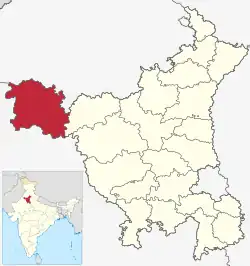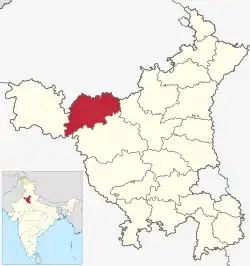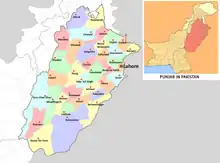Bagar region
Bagar, also Bagad (बागड़) a term meaning the "dry country",[1] is a region refers in north-western India and eastern parts of current Pakistan bordering north Rajathan, India where Bagri language is spoken inhabited by Ethenic Bagri people and was characterised by Sandy tracks and shifting sand dunes which are now irrigated by canals.[2]
Etymology
Bagar means the prairie (grazing shrubs and grassland) of northern Rajputana,[3] which likely comes from eponymous Arabic word "bagar" meaning "cow" (sacred to Hindus),[4] derived from the Arabic word "cattle".[5][6] Baggara in Arabic means "cattle herders".[5][7] Bagar tract refers to the semi-arid semi-fertile rain-fed sandy shrubby grassland tract at the confluence of arid Thar Desert and fertile bangar and khadir areas of Indo-Gangetic Plain, which as historically inhabited by the cattle herders who remained semi-nomadic until they began to adapt to settled life in the mid to late Medieval Period. Before the adoption of the Arabic name bagar, the area was earlier known as Jangladesh during the Vedic era of Mahabharata and even in early medieval times at least until the end of Hindu reign of Prithviraj Chauhan.
Bagar tracts
Bagar ( Hindi: बागङ) region is characterised by Bagar tracts which are long strips of shifting sand dunes called tibba (टिब्बा) and relatively semi-fertile lands and the area between them is called lal (लाळ ) in northern districts of Rajasthan and along the northwestern districts of Haryana[8]
Geography
The Bagar region has potentially very fertile alluvial soil interspersed with highly permeable very sandy tracts in several places with water table more than 100 feet below ground containing brackish water usually unfit for human consumption, where dust storms frequent during the warm summer months from April till the end of July when monsoon arrives. Previously the tract was solely based on the rain and irrigation was possible only in the small area of Bagar region in districts of Fatehabad, Sirsa, Hanumangarh, Sriganganagar and Anupgarh where the seasonal Ghaggar river flows.
Earlier Western Yamuna Canal and after 1963,Bhakra Nangal Dam canal system provides the water for irrigation in most of Haryana including all of the Bagar region falling in Haryana on its western border.
The Ganga canal in 1927 and in 1984 Indira Gandhi Canal irrigation also known as Rajathan Canal brought the water of Sutlej and Beas rivers to the fields of Rajasthan including its Bagar tract, stabilizing the sand dunes and soil erosion by preventing the expansion of desert.[9][8]
| States | Districts |
|---|---|
| 𝐑𝐚𝐣𝐚𝐬𝐭𝐡𝐚𝐧 | |
| 𝐏𝐮𝐧𝐣𝐚𝐛 (𝐈𝐧𝐝𝐢𝐚) |
|
| 𝐇𝐚𝐫𝐲𝐚𝐧𝐚 |
Bagri language
Bagri (बागड़ी), a dialect of overlapping Rajasthani language, Haryanvi language and Punjabi language of the Indo-Aryan family, spoken by about five million speakers residing in Bagar region of Rajasthan,Haryana and Punjab states in India[10][11]
In Punjab, Pakistan, Bagri as minor language is spoken in Bahawalpur district and Bahawalnagar district, though these are not considered parts of Bagar region.[10][11][13]
Bagri people

The term Bagri people was originally applied to Ethenic Jats,[14][15] Gurjars[16]Rajput and Bishnois living in Bagar Region and who speaks Bagri language[1][17][18][14][19][20][15]
There are also sections of Kumhar, Suthar, Nai, Agarwal Banias and Maheshwari banias as well as Badhik ("butcher"), Pardhi ("hunter"), Bawariya (semi-nomads) castes who are referred as Bagri living in the region.[18][20] Prominent bagri people are politician from Haryana
Mani Ram Bagri (1 January 1920 – 31 March 2012, a politician from Haryana), Raj Bagri, Baron Bagri (24 August 1930 – 26 April 2017, India-born British businessman and a Conservative member of the House of Lords from 1997 to 2010, who was made a life peer in 1997).[21]
Gallery


 Bagar tract through Ganganagar district,Anupgarh district, Hanumangarh district and Taranagar tehsil of Churu district in Rajasthan
Bagar tract through Ganganagar district,Anupgarh district, Hanumangarh district and Taranagar tehsil of Churu district in Rajasthan
 Bagri as minor language is spoken in Bahawalpur and Bahawalnagar district of Punjab, Pakistan, though not considered parts of Bagar tract.
Bagri as minor language is spoken in Bahawalpur and Bahawalnagar district of Punjab, Pakistan, though not considered parts of Bagar tract.
See also
References
- Nonica Datta, "Forming an identity", The Tribune, 3 July 1999.
- "Revised Land and Revenue Settlement of Hisar District 9006-9011" (PDF). Archived from the original (PDF) on 17 May 2017. Retrieved 26 March 2016.
- Elaine King,1998, Tales & legends of India, Page 61.
- 2002, Abubakar Garba, "State, city and society: processes of urbanisation", University of Maiduguri - Centre for Trans Saharan Studies, Archaeological Association of Nigeria, Page 82.
- Deepak Kumar Behera, Georg Pfeffer, 2002, The concept of tribal society, Page 284.
- Mohamet Lawan, 1997, No travel is little, Page 66.
- Jemera Rone, Brian Owsley, Human Rights Watch/Africa, 1996, Behind the Red Line: Political Repression in Sudan, Page 274.
- India District Census Handboook, 1961
- E. Walter Coward, 1980, "Irrigation and Agricultural Development in Asia: Perspectives from the social sciences", Cornell University press, page 302, ISBN 0801498716.
- Gusain, Lakhan: Reflexives in Bagri. Jawaharlal Nehru University, New Delhi, 1994
- Gusain, Lakhan: Limitations of Literacy in Bagri. Nicholas Ostler & Blair Rudes (eds.). Endangered Languages and Literacy. Proceedings of the Fourth FEL Conference. University of North Carolina, Charlotte, 21–24 September 2000
- Census India 2001
- Gusain, Lakhan: Bagri Grammar. Munich: Lincom Europa (Languages of the World/Materials, 2000, p. 384
- B.S. Nijjar, 2008, "Origins and History of Jats and Other Allied Nomadic Tribes of India: 900 B.C.-1947 A.D.", Atlantic Publishers, page 51, ISBN 8126909080.
- Nonica Datta, 1999, "Forming an Identity: A Social History of the Jats, Oxford University Press, page 12.
- Ajay Singh Rawat (1998). Forests on Fire: Ecology and Politics in the Himalayan Tarai. Cosmo Publications. pp. 80–. ISBN 978-81-7020-840-2.
- Robert Vane Russell, 1916, "pt. II. Descriptive articles on the principal castes and tribes of the Central Provinces", page 435.
- Robert Vane Russell, 1916, "The Tribes and Castes of the Central Provinces of India (Volumes I and II)", Library of Alexandria publication, ISBN 1465582940.
- 2000, "Haryana District Gazetteers: Rohtak district gazetteer, 1910", Government of Haryana Gazetteers organization, page 237.
- Vīrasiṃha, 2006, "The Jats: Their Role & Contribution to the Socio-economic Life and Polity of North & North-west India, Volume 2", page 305, ISBN 8188629529.
- Mosley, Charles, ed. (2003). Burke's Peerage, Baronetage & Knighthood (107 ed.). Burke's Peerage & Gentry. p. 219. ISBN 0-9711966-2-1.